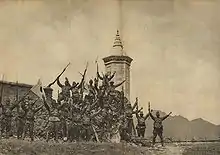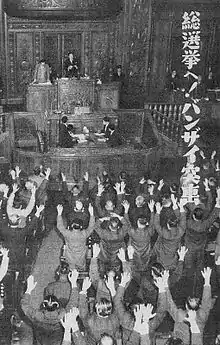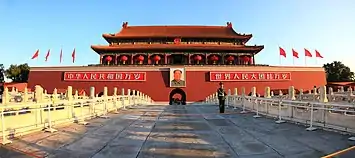Ten thousand years
In various East Asian languages, the phrase "ten thousand years" is used to wish long life, and is typically translated as "Long live" in English. The phrase originated in ancient China as an expression used to wish long life to the emperor. Due to the political and cultural influence of China in the area, and in particular of the Chinese language, cognates with similar meanings and usage patterns have appeared in many East Asian languages. In some countries, this phrase is mundanely used when expressing feeling of triumph, typically shouted by crowds.
| Ten thousand years | |||||||||||||||||||||||||||||
|---|---|---|---|---|---|---|---|---|---|---|---|---|---|---|---|---|---|---|---|---|---|---|---|---|---|---|---|---|---|
| Chinese name | |||||||||||||||||||||||||||||
| Traditional Chinese | 萬歲 | ||||||||||||||||||||||||||||
| Simplified Chinese | 万岁 | ||||||||||||||||||||||||||||
| |||||||||||||||||||||||||||||
| Vietnamese name | |||||||||||||||||||||||||||||
| Vietnamese | vạn tuế (萬歲),[1] muôn tuổi (𨷈𣦮),[1] muôn năm (𨷈𢆥)[1] | ||||||||||||||||||||||||||||
| Korean name | |||||||||||||||||||||||||||||
| Hangul | 만세 | ||||||||||||||||||||||||||||
| Hanja | 萬歲 | ||||||||||||||||||||||||||||
| |||||||||||||||||||||||||||||
| Japanese name | |||||||||||||||||||||||||||||
| Hiragana | ばんざい | ||||||||||||||||||||||||||||
| Kyūjitai | 萬歲 | ||||||||||||||||||||||||||||
| Shinjitai | 万歳 | ||||||||||||||||||||||||||||
| |||||||||||||||||||||||||||||
China
.jpg.webp)
In Chinese, ten thousand or "myriad" is the largest numerical order of magnitude in common usage, and is used ubiquitously as a synonym for "indefinitely large number". The term wansui (萬歲), literally meaning "ten thousand years", is thus used to describe a very long life for a person.
Although the First Emperor of Qin also wished "ten thousand generations" for his imperial empire, the use of wansui was probably coined during Han dynasty. In 110 BC, Emperor Wu of Han was addressed by the phrase "Wansui" on Mount Song. According to legend, Mount Song itself called out the phrase to address the emperor. During the Tang dynasty, it came to be used exclusively to address the emperor as a prayer for his long life and reign. Then, during the Five Dynasties and Ten Kingdoms period, its use was temporarily extended to include certain higher-ranking members of the imperial court,[2] but this tradition was relatively short-lived: in later imperial history, using it to address someone other than the emperor was considered an act of sedition and was consequently highly dangerous. During certain reigns of weak emperors, powerful eunuchs such as Liu Jin and Wei Zhongxian circumvented this restriction by styling themselves with jiǔ qiān suì (九千歲, literally "9,000 years") so as to display their high positions, which were close to or even exceeded the emperor's, while still remaining reverent to the title of the emperor.
Traditionally, empresses consort and empresses dowager were addressed with "thousand years" (千歲) rather than "ten thousand years", which was reserved for the emperor. However, Empress Dowager Cixi, the de facto supreme ruler of China from 1861 to 1908, was addressed with "ten thousand years". Several photographs of her[3] show a banner on her litter reading "The Incumbent Holy Mother, the Empress Dowager of the Great Qing, [will live and reign for] ten thousand years, ten thousand years, ten thousand of ten thousand years" (大清國當今聖母皇太后萬歲萬歲萬萬歲). The Emperor was addressed by the title "Lord of Ten Thousand Years" (simplified Chinese: 万岁爷; traditional Chinese: 萬歲爺; pinyin: Wànsuìyé).[4][5]
Usage
Classically, the phrase wansui is repeated multiple times following a person's name or title. For example, in ancient China, the Emperor would be thus addressed with (Chinese: 吾皇萬歲,萬歲,萬萬歲; pinyin: Wú huáng wànsuì, wànsuì, wànwànsuì; lit. '[May] my Emperor [live and reign for] ten thousand years, ten thousand years, ten thousand of ten thousand years'). The foregoing phrase is best known to modern Chinese through televised films, but is not historically accurate; in the Ming dynasty, the only occasion during which 萬歲 is used is the great court, held thrice a year. Approaching the end of the ceremony, the attending officials will be asked to shout 萬歲 three times. An important distinction made in Chinese but not in English is the use of suì (歲) to mean year, rather than the equally common nián (年), which is also translated as year. The former is used as a counter for years of life, whereas the latter is used for periods of time and calendar years. Thus the phrase "ten thousand years" in its original sense refers to ten thousand years of life, and not a period of ten thousand years.
The significance of "ten thousand" in this context is that "ten thousand" in Chinese and many other East Asian languages represents the largest discrete unit in the counting system, in a manner analogous to "thousand" in English. Thus 100,000 in Chinese is expressed as 10 ten-thousands; similarly, whereas a million is "a thousand thousands" in Western languages, the Chinese word for it is bǎiwàn (simplified Chinese: 百万; traditional Chinese: 百萬), which literally means "hundred ten-thousands". Because of this, Chinese people often use wàn in a manner analogous to "thousand" – whereas an English speaker might exclaim "there are thousands of ants on the ground", the Chinese speaker would substitute it with "ten thousand" in the description. So in the context of wànsuì, a literally incorrect but culturally appropriate translation might be, "may you live for thousands of years". The number simply denotes innumerability, in a manner etymologically similar to the Greek myriad (although the current usage of that word differs).
During the Qing, at the entrances of mosques in China, a tablet was placed upon which the characters for Huangdi, wansui, wansui, wanwansui (皇帝萬歲,萬歲,萬萬歲) were inscribed, which means, "The Emperor, may he live forever". Westerners traveling in China noted the presence of these tablets at mosques in Yunnan and Ningbo.[6][7]
During the Battle of Sihang Warehouse in 1937 during the Second Sino-Japanese War, Chinese civilians cheered "Zhōnghuá Mínguó wànsuì!" (Chinese: 中華民國萬歲!; lit. 'Long live the Republic of China!') after raising the Flag of the Republic of China on a flag-raising ceremony, to celebrate their victory over the Japanese.[8]
In August 1945, after Generalissimo Chiang Kai-shek announced the defeat of Japan in the Second Sino-Japanese War, the people exclaimed "Jiǎng... Zhōngguó... Wànsuì... Wànwànsuì!" (蔣...中國...萬歲...萬萬歲!), which means, "Chiang ... China ... live ten thousand years ... live ten thousand ten thousand years".[9]
Modern use
One of the most conspicuous uses of the phrase is at the Tiananmen gate in Beijing, where large placards are affixed to the gatehouse reading "中华人民共和国万岁"; pinyin: Zhōnghuá Rénmín Gònghéguó wànsuì; lit. '[may the] People's Republic of China [last for] ten thousand years') and "世界人民大团结万岁"; pinyin: Shìjiè rénmín dàtuánjié wànsuì; lit. '[may] the Great Unity of the world's people [last for] ten thousand years').
During the Cultural Revolution, the saying 毛主席万岁 (pinyin: Máo Zhǔxí Wànsuì; lit. '[may] Chairman Mao [live for] ten thousand years!') was also common. After Mao's death, the phrase has never been used for any individual. Apart from these special cases, the phrase is almost never used in political slogans today. In casual conversation, however, the phrase is used simply as an exclamation of joy. For example, CCTV commentator Huang Jianxiang shouted "Yìdàlì wànsuì" (simplified Chinese: 意大利万岁; traditional Chinese: 義大利萬歲; lit. 'Italy ten thousand years!'; translated as "Forza Italia!" by some media) after Francesco Totti’a goal during Italy’s match against Australia in the 2006 FIFA World Cup. Taiwan-based singer Leehom Wang's 2007 album Change Me contains a song called "華人萬歲" (Húarén Wànsùi; 'Long Live Chinese People').
Within the Republic of China, shouting the phrase 中華民國萬歲; pinyin: Zhōnghuá mínguó wànsuì!; lit. '[may] the Republic of China [live for] ten thousand years!', translated as Long Live the Republic of China!) has been the final act ending presidential speeches on the National Day of the Republic of China, a tradition which was broken in 2016. It has been combined in recent years with another saying, 台灣民主萬歲 (Táiwān mínzhǔ wànsuì; '[may] a democratic Taiwan [live for] ten thousand years!', translated as Long Live the Democratic Taiwan!) When this is said, everyone raises their right fists while standing.
Chinese authorities censored the phrase in 2018 after their decision to abolish term limits on the Chinese presidency. It was feared that it could be used ironically to mock the alleged aspirations of Xi Jinping to become president for life.[10] Xi is also the General Secretary of the Communist Party of China, the de facto paramount leader with no term limits.[11][12]
In Cantonese, "ten thousand years" (萬歲) can also be a slang term for treating others to foods and drinks.[13]
Japan


The Chinese term was introduced to Japan as banzai (Kana: ばんざい; Kanji: 万歳) in the 8th century, and was used to express respect for the Emperor in much the same manner as its Chinese cognate.
Even earlier, however, according to the Nihongi, during the reign of Empress Kōgyoku, A.D. 642, 8th Month, 1st Day:
The Emperor made a progress to the river source of Minabuchi. Here, (s)he knelt down and prayed, worshipping towards the four quarters and looking up to the Heaven. Straightway there was thunder and a great rain, which eventually fell for 5 days, and plentifully bedewed the Empire. Hereupon the peasantry throughout the Empire cried with one voice: "Banzei" and said "an Emperor of exceeding virtue".
Banzei was later revived as banzai (Kana: ばんざい) after the Meiji Restoration. Banzai as a formal ritual was established in the promulgation of the Meiji Constitution in 1889 when university students shouted banzai in front of the Emperor's carriage.[14]
Around the same time, banzai also came to be used in contexts unrelated to the Emperor. The supporters of the Freedom and People's Rights Movement, for example, began to shout "Jiyū banzai" (Kanji: 自由万歳; Kana: じゆうばんざい, or, roughly, "Long Live Freedom") in 1883.
During World War II, banzai or its full form Tennōheika Banzai! (天皇陛下万歳, "Long Live His Majesty the Emperor") served as a battle cry of sorts for Japanese soldiers.[15] Ideally, kamikaze pilots would shout "banzai!" as they rammed their planes into enemy ships; although Japanese popular culture has portrayed this romanticized scene, it is unknown if any pilot actually did so. Its confirmed use by ground troops, however, was heard in numerous battles during the Pacific Campaign, when Japanese infantry units attacked Allied positions. As a result, the term "banzai charge" (or alternatively "banzai attack") gained common currency among English-speaking soldiers and remains the most widely understood context of the term in the West to this day.
Modern use
Traditionally, "banzai" (roughly translated as "hurrah", literally translated as "ten thousand years") was an expression of enthusiasm, and crowds shouting the word three times, arms stretched out above their heads, could be considered the traditional Japanese form of applause.[16] More formally, the word is shouted three times during the dissolution of the House of Representatives, and also as an acclamation at the enthronement of the Japanese Emperor.
Korea
The same term is pronounced manse (Korean: 만세; Hanja: 萬歲) in Korean. In Silla, it was used as a casual exclamation. It was a part of the era name of Taebong, one of the Later Three Kingdoms declared by the king Gung Ye in 911. During Joseon, Koreans used cheonse (Korean: 천세; Hanja: 千歲, "one thousand years") in deference to the Chinese emperor's ten thousand years.
In the 20th century, various protests against Japanese occupation used the term in their names, including a pro-independence newspaper established in 1906, the March 1st Movement of 1919, and the June 10th Movement of 1926.
In North Korea, manse was used to wish long life for Kim Jong-il, and for the political principles of his father, Kim Il-sung. It is now used to wish Kim Jong-un with a long life. Akin to the "banzai charge" used by Japanese servicemen during the Pacific War, the Korean People's Army used Widaehan Suryŏng Kim Ilsŏng Janggun Manse! (위대한 수령 김일성장군 만세; 偉大한 首領 金日成將軍 萬歲; "Long live the Great Leader, General Kim Il-sung") as a charge mantra during the Korean War.
It is also used as a casual proclamation, commonly used as the English equivalent of "Victory."
Vietnam


In Vietnamese, "vạn tuế" is the phrase cognate to the Chinese wàn suì and is the Sino-Vietnamese reading of Chinese: 萬歲. However, this word is rarely used in the modern language, appearing instead only in China-related contexts (such as in "vạn tuế, vạn tuế, vạn vạn tuế"—compare to Chinese usage, above). In other situations, "muôn năm" is used instead, and is frequently heard in communist slogans, such as "Hồ Chí Minh muôn năm!" (Long life to Ho Chi Minh) and "Đảng cộng sản muôn năm!" (Long live the Communist party). Just like the Japanese banzai, it is said 3 times.
Muôn is the Old Sino-Vietnamese reading of the Chinese character 萬 (Sino-Vietnamese reading: vạn).[17]
Tuổi is the Old Sino-Vietnamese reading of the Chinese character 歲 (Sino-Vietnamese reading: tuế).[18] It is derived from the pronunciation of this character in Middle Chinese.[19]
Năm is a native Vietnamese word that inherited from the Proto-Mon-Khmer language (cognates with Khmer ឆ្នាំ and Mon သၞာံ).[20]
There are many ways to write the words muôn tuổi, muôn năm in chữ Nôm characters, for example:
Elsewhere
In Portuguese the word "banzé" (how it would have looked and sounded to the Portuguese in Japan in the 16th century), directly taken from the Japanese "banzai," is still used as meaning a lot of noise made by a gathering of people.
See also
- In saecula saeculorum
- Joy Bangla
- Polychronion Orthodox Chant with similar meaning, sung to the Orthodox Authorities
- The king is dead, long live the king!, a traditional European saying, used to wish for long life of the monarch, said when a new king ascends to the throne
- Sto lat, a similar Polish phrase and song meaning "one hundred years"
- Mabuhay, a traditional Philippine cheer meaning "May you live long!"
- Oorah
- Vive, viva, and vivat
References
- Viện Ngôn ngữ học (2003). Từ điển tiếng Việt. Nhà xuất bản Đà Nẵng, Trung tâm Từ điển học. p. 1097.
- Ouyang, Xiu. Davies, Richard L. [2004] (2004). Historical Records of the Five Dynasties. Columbia university press. ISBN 0-231-12826-6
- 瑞丽女性网-生活-揭密慈禧太后奢侈生活. rayli.com.cn (in Chinese). 2007-01-26. Archived from the original on 2008-06-09. Retrieved 2008-05-08.
- Current literature, Volume 51. Current Literature Pub. Co. 1911. p. 624. Retrieved 2011-07-06.
- Edward Jewitt Wheeler, Frank Crane (1911). Current opinion, Volume 51. The Current Literature Publishing Co. p. 624. Retrieved 2011-07-06.
- The Chinese repository, Volumes 11-15. Printed for the proprietors. 1842. p. 33. Retrieved 2010-06-28.
- Michael Dillon (1999). China's Muslim Hui community: migration, settlement and sects. Richmond: Curzon Press. p. 77. ISBN 0-7007-1026-4. Retrieved 2010-06-28.
- "Our Determined Lone Army Makes Final Stand". Lihpao Daily 29 October 1937
- "CHINA: Wan Wan Sui!". TIME. Aug 27, 1945. Retrieved May 22, 2011.
- "China bans the letter 'N' from the internet amid crackdown". The Irish Times. Retrieved 2018-04-01.
- Chris Buckley and Adam Wu (10 March 2018). "Ending Term Limits for China's Xi Is a Big Deal. Here's Why. - Is the presidency powerful in China?". New York Times.
In China, the political job that matters most is the general secretary of the Communist Party. The party controls the military and domestic security forces, and sets the policies that the government carries out. China’s presidency lacks the authority of the American and French presidencies.
- "China sets stage for Xi to stay in office indefinitely". Reuters. 2018-02-25.
However, the role of party chief is more senior than that of president. At some point, Xi could be given a party position that also enables him to stay on as long as he likes.
- Zeng, Zifan (2008). A Study of Idiomatic Expressions in Hong Kong Cantonese (in Chinese). Hong Kong: City University of Hong Kong Press. p. 355. ISBN 978-962-937-147-0.
- Makihara, Norio. “The Birth of Banzai.” Japan Forum 23, no. 2 (June 2011): 237–61. doi:10.1080/09555803.2011.599272.
- p.3, The Cambridge history of Japan, by John Whitney Hall, 1988 Cambridge University Press, ISBN 0-521-22352-0
- teacher, Namiko Abe Namiko Abe is a Japanese language; translator; years, as well as a Japanese calligraphy expert She has been a freelance writer for nearly 20. "How to Master Important Japanese Gestures". ThoughtCo.
- Lý, Lạc Nghị; Waters, Jim (1997). Tìm về cội nguồn chữ Hán. Hà Nội: Nhà xuất bản Thế Giới. p. 1027.
- Lý, Lạc Nghị; Waters, Jim (1997). Tìm về cội nguồn chữ Hán. Hà Nội: Nhà xuất bản Thế Giới. p. 1124.
- Nguyễn, Khuê (2009). Chữ Nôm: cơ sở và nâng cao. Nhà xuất bản Đại học Quốc gia Thành phố Hồ Chí Minh. p. 50.
- This term is unrelated to Chinese 年 (Sino-Vietnamese reading: niên) that it is often mistakenly believed to be derived from.
- Vũ, Văn Kính (2005). Đại tự điển chữ Nôm. Nhà xuất bản Văn nghệ Thành phố Hồ Chí Minh. pp. 850, 1317.
- Vũ, Văn Kính (2005). Đại tự điển chữ Nôm. Nhà xuất bản Văn nghệ Thành phố Hồ Chí Minh. pp. 850, 868, 869.

